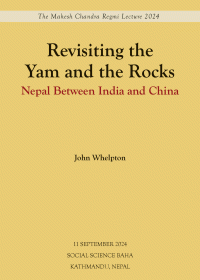Publications
Revisiting the Yam and the Rocks: Nepal Between India and China
In his Dibya Upadesh, Prithvi Narayan Shah famously compared Nepal’s relations with her giant neighbours to a yam sandwiched between two rocks. From the foundation of the modern Nepali state in the 18th century till the 1840s, Nepal’s rulers sought to balance between India and China, using one to counteract the influence of the other. The enfeeblement of China in the 19th century led to the replacement of this strategy by one of alliance with British India, but there was a return to the traditional stance under King Mahendra. Nevertheless, the aspiration for geostrategic equidistance from her two neighbours contrasts with the much easier accessibility and closer cultural and economic ties to India, which have helped that country exercise influence in the internal politics of Nepal. Equidistance has also been made more difficult because Nepal’s position on the south side of the Himalaya makes it of much greater strategic significance to India than to China, whose overriding concern has been simply the maintenance of full control on the north side of the range. Recent years have seen considerable strengthening of Chinese economic ties with Nepal and the beginning of Chinese involvement in Nepali politics, trends which are likely to continue. Some hope and others fear the end result might be a fundamental transformation of the traditional pattern through infrastructural links with Tibet, offsetting economic dependence on India. An even more radical change might be a full rapprochement between China and India or even, as suggested by John Garver, the latter’s accepting a position as the former’s junior partner. However, tectonic shifts on these lines are most unlikely in the foreseeable future: tensions between India and China look set to continue and, despite King Birendra’s assertion in 1973 that Nepal is ‘not a part of the subcontinent [but] that part of Asia which touches both China and India’, the predominant importance of the southern connection will persist.
John Whelpton is a historian and linguist who has worked in and on Nepal since 1972. After graduating in Classics from Trinity College, Oxford, he taught English as a volunteer college lecturer at Thakur Ram Campus in Birgunj and Amrit Science Campus in Kathmandu for two years. Following a spell in the British civil service, he returned to academia and completed a PhD on 19th-century Nepali politics from the School of Oriental and African Studies, University of London. Since 1987, he has been based in Hong Kong, working as a Native-speaking English Teacher (NET) and then as a tutor of Latin.
Dr Whelpton has written extensively on Nepal’s history and politics. Among this books are: Jang Bahadur in Europe: The First Nepalese Mission to the West; Kings, Soldiers, and Priests: Nepalese Politics and the Rise of Jang Bahadur Rana, 1830-1857; Nationalism and Ethnicity in a Hindu Kingdom: The Politics of Culture in Contemporary Nepal (co-editor); People, Politics & Ideology: Democracy and Social Change in Nepal (co-author); and
A History of Nepal.

